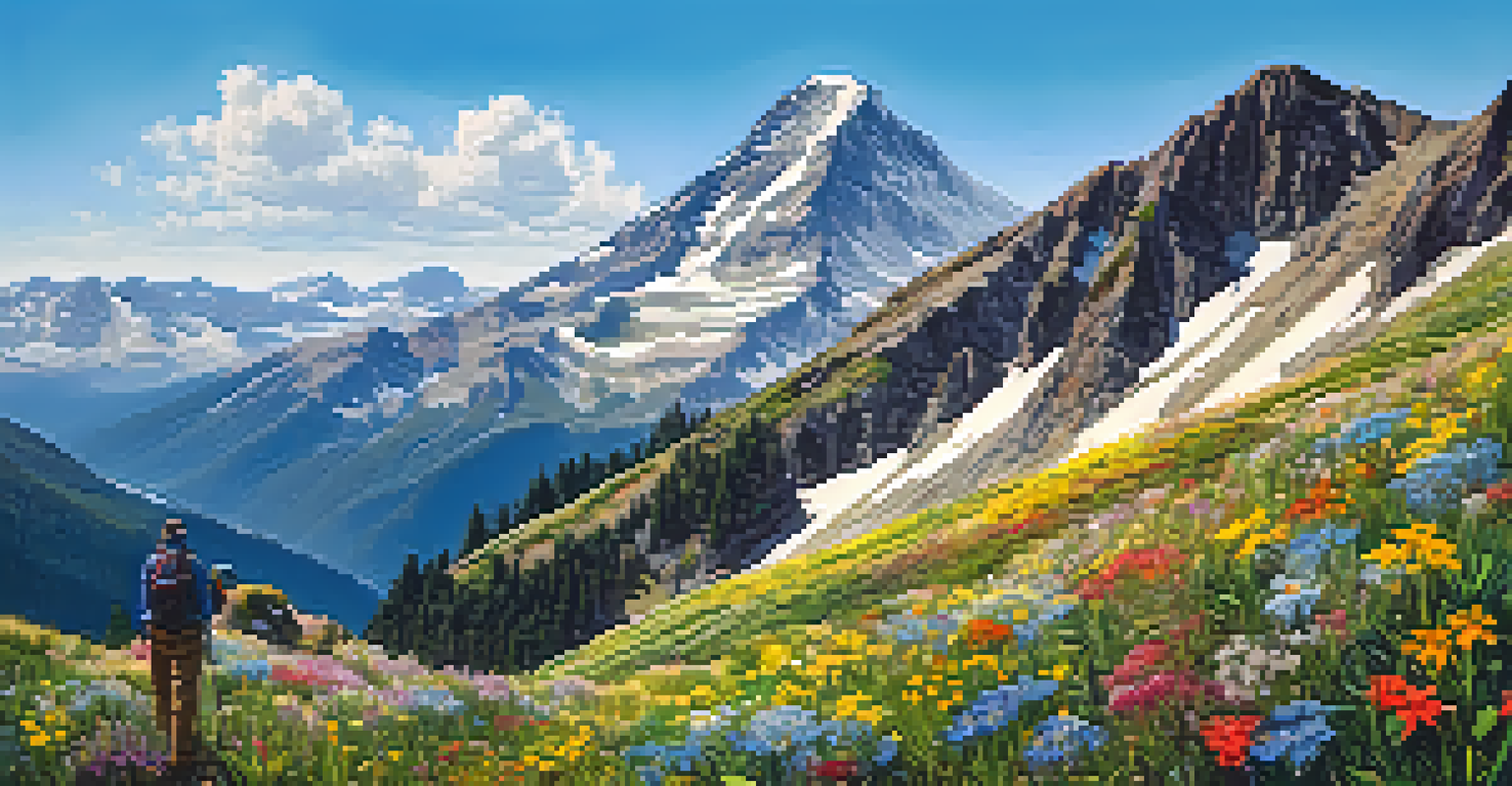Sacred Landscapes: Nature's Role in Spiritual Exploration

Understanding Sacred Landscapes and Their Significance
Sacred landscapes are areas of land imbued with spiritual meaning, often revered in various cultures. These locations can range from majestic mountains to serene forests, each offering a unique connection to the divine or transcendent. They serve as natural sanctuaries where individuals seek solace, reflection, and a deeper understanding of themselves and the universe.
In every walk with nature one receives far more than he seeks.
In many traditions, these landscapes are seen as more than just physical spaces; they are viewed as living entities that hold wisdom and power. For example, indigenous cultures often regard specific natural sites as sacred, believing they are the dwelling places of spirits. This perspective fosters a profound respect for nature, highlighting the interconnectedness of all living things.
Visiting these sacred spaces can lead to transformative experiences. Whether it’s standing atop a mountain peak or walking through an ancient forest, individuals often report feelings of awe, peace, and clarity. Such experiences can help people reconnect with their spirituality and encourage personal growth.
Nature as a Catalyst for Reflection and Introspection
Nature provides a tranquil backdrop that encourages reflection and introspection. The gentle rustle of leaves, the sound of flowing water, or the sight of a vast sky can help quiet the mind, making it easier to explore one’s thoughts and feelings. This peaceful environment can be a powerful tool for self-discovery.

For instance, many people find that hiking in nature allows them to process emotions or think through life challenges. The rhythmic movement of walking combined with the beauty of the surroundings can inspire new insights and solutions. This process of reflection is often enhanced by the natural world, which serves as a mirror for our inner experiences.
Sacred Landscapes Foster Connection
These areas provide a unique opportunity for individuals to connect with nature and their spirituality.
Engaging with nature can also lead to a deeper understanding of one’s place in the world. By observing the cycles of life in the natural environment, individuals may come to appreciate the ebb and flow of their own lives. This connection fosters a sense of belonging and purpose, which can be incredibly enriching on a spiritual level.
The Healing Power of Nature in Spiritual Practices
Nature is often recognized for its healing properties, both physically and spiritually. Many spiritual practices incorporate natural elements, believing that they enhance the effectiveness of rituals and meditative exercises. For example, the use of crystals, herbs, and even water are common in various traditions, all of which have their roots in the natural world.
Nature does not hurry, yet everything is accomplished.
Spending time in nature has been shown to reduce stress and anxiety, promoting emotional well-being. This healing aspect can be particularly beneficial for those on a spiritual journey, as it allows individuals to clear their minds and open their hearts. The calming effects of nature can facilitate deeper meditative states, making it easier to connect with the divine.
Moreover, many spiritual retreats take place in natural settings, emphasizing the importance of the environment in fostering healing and growth. These retreats often encourage participants to immerse themselves fully in the landscape, participating in activities like yoga, meditation, and mindfulness practices. Such experiences underscore the belief that nature itself is a vital partner in one's spiritual exploration.
Myths and Stories: Nature's Role in Spiritual Traditions
Throughout history, nature has been a central theme in many spiritual myths and stories. These narratives often illustrate the relationship between humans and the natural world, highlighting the lessons that can be learned from it. For instance, many cultures have creation myths that involve elements of nature, showcasing the interconnectedness of all life.
These stories serve not only to entertain but also to impart wisdom. They often convey moral lessons that encourage respect for the environment and an understanding of our place within it. By sharing these tales, communities pass down their values and beliefs, fostering a deep appreciation for the sacredness of the landscapes around them.
Nature Enhances Self-Reflection
The tranquility of natural settings encourages introspection, helping individuals process emotions and gain insights.
Additionally, many spiritual practices incorporate storytelling as a way to connect with nature. By recounting myths or personal experiences related to specific landscapes, individuals can deepen their spiritual connection. This practice of sharing stories helps to keep the spirit of the landscape alive, ensuring that its significance is recognized and honored.
Pilgrimages: Journeying Through Sacred Landscapes
Pilgrimages are a significant aspect of many spiritual traditions, often involving journeys to sacred landscapes. These journeys can be physical, emotional, or spiritual, providing individuals with an opportunity for deep introspection and connection. Pilgrims often seek to experience the transformative power of these landscapes as they walk paths that have been traveled for centuries.
The act of pilgrimage is not just about the destination; it's also about the journey itself. As pilgrims traverse diverse terrains, they undergo personal changes that can lead to profound realizations. This journey often mirrors an inner quest, where each step taken in nature brings clarity and purpose.
Many famous pilgrimage routes, such as the Camino de Santiago in Spain or the Kumbh Mela in India, highlight the significance of sacred landscapes in spiritual exploration. These journeys attract individuals from all walks of life, united by their desire to seek meaning and connection. The shared experience fosters a sense of community, emphasizing the importance of nature in spiritual growth.
Nature and Mindfulness: Cultivating Presence in Sacred Spaces
Mindfulness is the practice of being fully present in the moment, and nature can serve as an excellent backdrop for cultivating this awareness. Sacred landscapes, with their beauty and tranquility, provide an ideal setting for mindfulness practices. By immersing oneself in nature, individuals can enhance their ability to focus on the here and now, fostering a deeper spiritual connection.
Engaging with nature mindfully can involve simple activities, such as observing the details of a flower or listening to the sounds of the forest. These mindful moments can help individuals connect with their surroundings and, in turn, their inner selves. This practice encourages a sense of gratitude and appreciation for the world around us.
Pilgrimages Offer Transformative Journeys
Physical and spiritual journeys through sacred landscapes promote personal growth and a deeper understanding of oneself.
Moreover, mindfulness in nature has been linked to increased emotional resilience and well-being. By regularly practicing mindfulness in sacred landscapes, individuals can develop a greater capacity to cope with life’s challenges. This enhanced awareness not only enriches spiritual exploration but also promotes a more fulfilling life.
Conclusion: Embracing Nature in Spiritual Exploration
In conclusion, sacred landscapes play a vital role in spiritual exploration, offering individuals a space to connect with nature and themselves. Whether through reflection, healing, or pilgrimage, these natural environments provide unique opportunities for growth and understanding. Embracing nature can enhance spiritual practices and deepen personal experiences.
As we navigate our spiritual journeys, it’s essential to recognize the significance of our natural surroundings. By appreciating the beauty and wisdom found in sacred landscapes, we can foster a more profound connection to the divine and the world around us. Nature invites us to slow down, reflect, and engage with our spirituality in meaningful ways.

Ultimately, the journey through sacred landscapes is an invitation to explore not just the outer world but also our inner landscapes. By allowing nature to guide us, we can discover insights that lead to greater fulfillment and spiritual enlightenment.